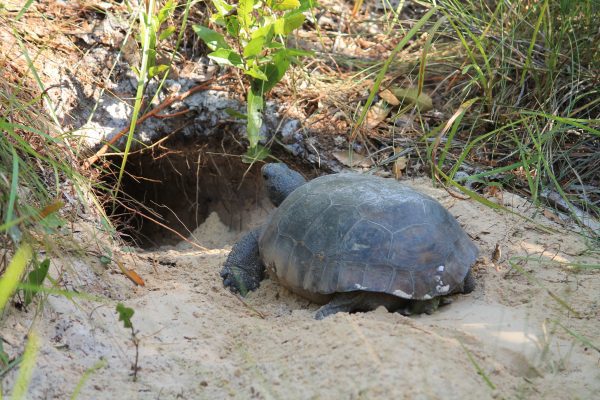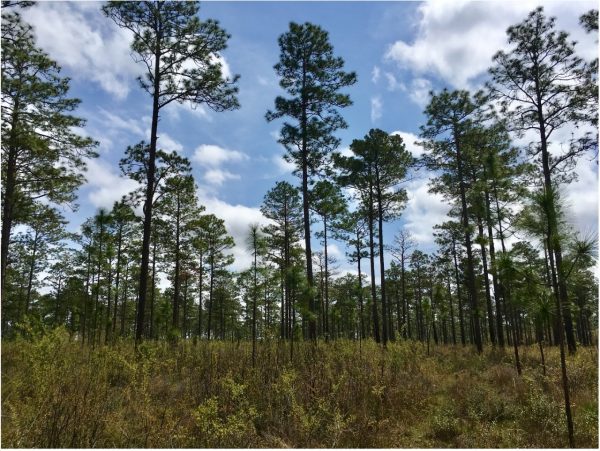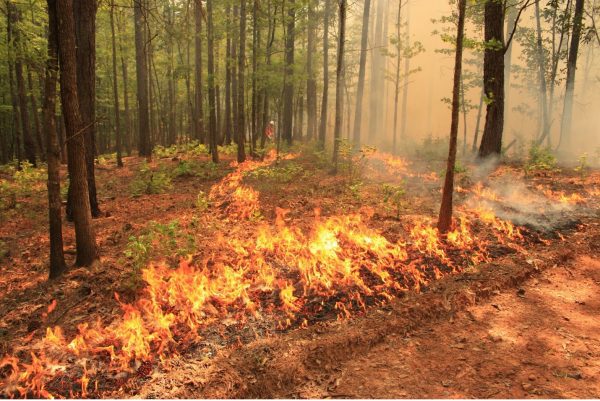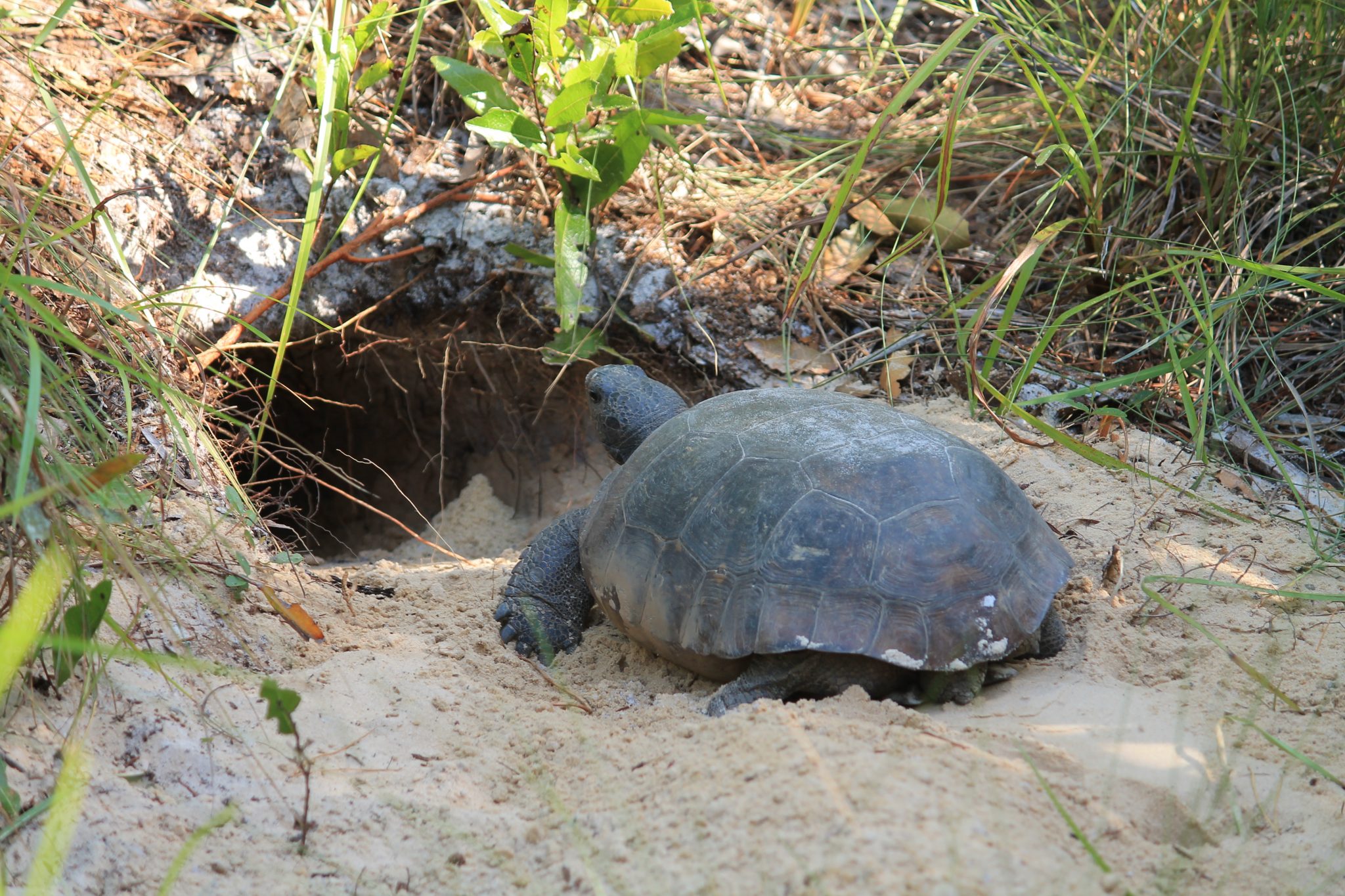Natural Resources


Figure 1. Gopher tortoise in front of burrow entrance. iStock photo by Shellphoto.
The gopher tortoise (Gopherus polyphemus) is one of four North American tortoise species, ranging along the Southeastern Coastal Plain region of Georgia, Florida, Alabama, Mississippi, and in small parts of South Carolina and Louisiana. These moderately-sized tortoises have shovel-like forelimbs designed to dig burrows as seen in fig. 1. Gopher tortoises and their burrows are essential to coastal plain ecosystem function and stability. Their burrowing activity makes them a keystone species, a species on which others largely depend.
Gopher tortoises are protected by the State of Alabama throughout their range. They are federally protected in Louisiana, Mississippi, and in Alabama west of the Mobile River and Tombigbee River. This protection status is essential because of population declines greater than 80 percent over the past century (USFWS, 2019). The habitat range for gopher tortoises is mostly privately owned forestland. Therefore, the management decisions of private landowners may significantly impact the status and future of this keystone species.
Gopher Tortoise Ecology
Gopher tortoises live in areas with ample sunlight reaching the ground to help them regulate their temperature and warm their nests. These conditions are common in xeric hammocks, sandhill environments, and pine savannas. Gopher tortoises feed on vegetation that helps to disperse seeds. Gopher tortoises are primarily herbivorous, satisfying most of their nutrient and water requirements by consuming over 60 different genera of vegetation. The most frequently consumed plants are members of Poaceae (grass family), Asteraceae (daisy family), Fabaceae (bean family), Pinaceae (pine family), and Fagaceae (oak family). Wiregrass (Aristida spp.) is a member of Poaceae common to sandhill environments and is frequently eaten by adult gopher tortoises. Many of these plant families are represented in fig. 2. This photo was taken at the Geneva State Forest and shows a suitable habitat for a gopher tortoise with an open canopy, minimal midstory, and diverse understory.

Figure 2. Gopher tortoise habitat with open canopy and ample understory vegetation.
In environments with a diverse understory as seen in fig. 2, gopher tortoises feed on the available forage. Gopher tortoises forage for plants typically within 100 feet of their burrow. Travel outside this range is influenced by social interaction, environmental changes, and resource availability. For example, areas without frequent low-intensity fire will transition from herbaceous to woody vegetation that is not preferred by gopher tortoises. This gradual change in species composition within an ecosystem, results in more frequent burrow abandonment. If open pine ecosystems transition to a closed midstory, conditions become unsuitable to the gopher tortoise.
In addition to an open canopy, gopher tortoises require well-drained sandy soil for burrowing, such as sandy hills in a pine savanna. Frequent and low-intensity fire is needed to maintain the composition of plants that provide an ideal habitat for this species. Gopher tortoises dig burrows to regulate temperature fluctuations and to protect themselves from fires. These burrows average 14.8 feet in length, have a rounded top, flat bottom, and an opening the size of the tortoise. Burrowing impacts ecosystems by enhancing soil nutrient cycling and increasing biodiversity. The burrows provide refuge for over 360 species, such as the indigo snake (Drymarchon corais couperi), the Florida mouse (Peromyscus floridanus), and the gopher frog (Lithobates capito). Burrows with active gopher tortoises are visited more often by a wide range of species compared to burrows with inactive gopher tortoises. The apron of sand collected at the burrow entrance forms a microhabitat where plants grow and provides a refuge for reptiles, such as the sand skink (Neoseps reynoldsi) and mole skink (Eumeces egregious). These mounds have lower soil nutrient concentration, lower soil organic matter, higher light intensity, and greater diurnal temperature fluctuations on average compared to the undisturbed ground surrounding the mounds.
Population Decline
Population declines reported for gopher tortoises are largely because of environmental degradation. The range of the longleaf pine ecosystem has decreased over 85 percent leading to land fragmentation and widespread loss of gopher tortoise populations. Conservation efforts must be maintained because long-term population declines are projected to occur.
Hardwood species encroachment and thickly planted pine reduce light penetration through the canopy, thereby contributing to population decline. Implementing a growing season fire regime reduces this hardwood encroachment. In environments with closed canopies, gopher tortoises may relocate to open habitats near roadways, and this relocation increases the chance of injury or death.
Human predation on gopher tortoises is rare now, though predation peaked during the Great Depression when gopher tortoises were referred to as “Hoover Chicken.” Humans now, however, impact gopher tortoise populations by habitat fragmentation. For example, construction of roads and railways increase habitat fragmentation and population isolation. Gopher tortoises living on agricultural or urban land are at risk of injury from vehicles because of their limited mobility. Because of this risk, it is legal to move a gopher tortoise across a road to safety. However, it is against the law to capture, hunt, harass, possess, sell, or transport a gopher tortoise or gopher tortoise eggs. It is also unlawful to damage or destroy gopher tortoise burrows. These laws also apply to gopher tortoises found on residential properties. To remove the gopher tortoise from a residential area, a permit is required from the Fish and Wildlife Service. Gopher tortoise populations can be helped by reducing crowding among isolated populations to prevent the spread of disease. One such disease contributing to the gopher tortoise decline in Florida and Alabama is upper respiratory tract disease (URTD). This disease is caused by the bacteria Mycoplasma agassizii. Signs of URTD in gopher tortoises include nostril discharge, eyelid swelling, conjunctivitis, lethargy, dehydration, and emaciation. In severe cases, URTD will result in death.
Conservation
Monitoring populations is an important step in conserving wildlife. By using repeated observational surveys, radar tracking, cameras, and mark-and-release, researchers can understand trends of localized populations of gopher tortoises over long periods of time.
Gopher tortoise habitats are characterized by minimal to moderate canopy cover, variation in tree age, and diverse understory. Therefore, maintaining and restoring pine ecosystems may benefit gopher tortoise populations. Prescribed burning every 2-5 years, depending on the composition of plants in an ecosystem, helps to maintain open pine systems. Burns can be facilitated by reintroducing fire-adapted pines to an ecosystem. As part of the USDA Longleaf Pine Initiative, financial assistance is provided for approved participants to implement conservation practices, such as planting longleaf pines. Figure 3 shows a prescribed burn that helps to manage and restore pine ecosystems.

Figure 3. Prescribed burn.
Over 80 percent of gopher tortoise habitat in the Southeast United States is privately owned. Therefore, management practices by landowners are essential for conservation. However, with increasing agricultural demands and population growth, trees can be planted more densely in private pine stands to increase canopy closure. Management practices like prescribed fire, thinning, and chemical control of woody species in pine-based plantations enhance biodiversity without sacrificing economic thresholds (Greene et al., 2019). Managing areas adjacent to plantations may also benefit the gopher tortoise. For example, sandy ridges near commercial pine stands can be managed as natural corridors to help disperse gopher tortoise populations. A larger land area also reduces the spread of diseases like UTRD that worsens by crowding.
Maintaining a diverse understory is important because gopher tortoises require high availability of forages. These are often plants that develop within the first couple of years after a disturbance. Planting native species, such as wiregrass and prickly pear, provide food for gopher tortoises.
Physical barriers can protect hatchling and adult gopher tortoises from predators and vehicles. Trenches or tunnels bypassing railways offer protection from vehicles and maintain habitat connectivity (Rautsaw et al., 2018). With heavy machinery in agriculture, logging, or construction, gopher tortoises may become entombed in their burrows. Visibly flagging a 13-foot radius buffer zone around the burrow entrance can safeguard gopher tortoise health by reducing the risk of burrow damage. It is important to avoid blocking or disturbing the gopher tortoise or its burrow in any way.
Widespread efforts are being made to conserve the gopher tortoise and to restore the range of the longleaf pine savanna. Gopher tortoises have been relocated to the Geneva State Forest, and hundreds of active and inactive burrows are being monitored there. Numerous sites at the Conecuh National Forest are managed specifically for gopher tortoise populations. Although the state of Alabama currently has fewer gopher tortoises, populations are being retained and ecosystems are being restored.
Summary
The gopher tortoise is a keystone species native to southeastern coastal plains. This species is essential to ecosystem function because of its feeding patterns and burrowing activity. Gopher tortoise populations have dropped in recent years because of disease, predation, and habitat decline. Conservation efforts are being prioritized to support gopher tortoise population growth. Pine savanna restoration efforts provide gopher tortoises with quality habitats. Enhancing understory diversity increases forage quantity. Reducing habitat fragmentation increases gopher tortoise dispersal. It is important to continue these conservation practices to protect this threatened species.
Selected References
Auffenberg, Walter, and Richard Franz. 1982. “The Status and Distribution of the Gopher Tortoise (Gopherus polyphemus).” Wildlife Research Report. 12 (126): 95-126.
Traci D. Castellón, B. B. Rothermel, and Javan M. Bauder. 2018. “Gopher Tortoise Burrow Use, Home Range, Seasonality, and Habitat Fidelity in Scrub and Mesic Flatwoods of Southern Florida.” Herpetologica. 74 (1): 8-21.
Michelina C. Dziadzio, and Lora L. Smith. 2016. “Vertebrate Use of Gopher Tortoise Burrows and Aprons.” Southeastern Naturalist, 15 (4): 586-594.
Jeffrey M. Goessling, Craig Guyer, James C. Godwin, Sharon M. Hermann, Franzisca C. Sandmeier, Lora L. Smith, and Mary T. Mendonça. 2019. “Upper Respiratory Tract Disease and Associated Diagnostic Tests of Mycoplasmosis in Alabama Populations of Gopher Tortoises, Gopherus polyphemus.” PloS ONE. 14 (4), e0214845.
Jeffrey M. Goessling, Jonathan M. Stobler, Sybil G. Gyengo, Sharon M. Hermann, Tracey D. Tuberville, and Frank Guyer. 2020. “Implications From Monitoring Gopher Tortoises at Two Spatial Scales.” The Journal of Wildlife Management. 85 (1): 135-144.
Rachel E. Greene, Raymond Iglay, Kristine O. Evans, Thomas Bentley Wigley, and Darren A. Miller. 2019. “Estimating Capacity of Managed Pine Forests in the Southeastern U.S. to Provide Open Pine Woodland Condition and Gopher Tortoise Habitat.” Forest Ecology and Management. 432: 200-208.
Hunter Howell, Betsie B. Rothermel, K. Nicole White, and Christopher Searcy. 2020. “Gopher Tortoise Demographic Responses to a Novel Disturbance Regime.” The Journal of Wildlife Management. 84 (1): 56-65.
Earl D. McCoy, Henry R.Mushinsky, and Jonathan Lindzey. 2006. “Declines of the Gopher Tortoise on Protected Lands.” Biological Conservation. 128 (1): 120-127.
Esther S. Parish, Latha M. Baskaran, and Virginia H. Dale. 2020. “Framework for Assessing Land-Management Effects on At-risk Species: Example of SE USA Wood Pellet Production and Gopher Tortoise (Gopherus polyphemus).” Wiley Interdisciplinary Reviews: Energy and Environment, e385.
Rhett M. Rautsaw, Scott Anthony Martin, Bridget Vincent, Katelyn Susanne Lanctot, Rebecca Bolt, Richard A. Seigel, and Christopher L. Parkinson. 2018. Stopped Dead in Their Tracks: The Impact of Railways on Gopher Tortoise (Gopherus polyphemus) Movement and Behavior.” Copeia. 106 (1): 135-143.
Helen E. Tripp, Robert A. Gitzen, and Amy L. Silvano. 2019. “Individual-based Modeling to Project Viability of Gopher Tortoise Populations Under Alternative Management Scenarios: A Case Study With Two Alabama Wildlife Management Areas. Journal of the Southeastern Association of Fish and Wildlife Agencies. 5: 150-159.
United States Fish and Wildlife Service (USFWS). 201. “Gopher tortoise (Gopherus polyphemus).” USFWS North Florida Ecological Services Office.
 Mary Dixon, Urban Regional Extension Agent, Alabama A&M University.
Mary Dixon, Urban Regional Extension Agent, Alabama A&M University.
New August 2021, Gopher Tortoise Ecology and Conservation, UNP-2183

